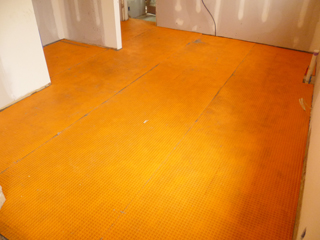 Last fall I attended a class from Schluter Systems about some of their products including Ditra. Ditra is the orange-colored waffle-looking stuff on the floor in this picture. It’s not only much easier and cleaner to install than cementboard, but it’s touted as being a superior underlayment to actually give you a better tile installation over the years. It was interesting to learn about some of the reasons Ditra works so well and is such a great product to use.
Last fall I attended a class from Schluter Systems about some of their products including Ditra. Ditra is the orange-colored waffle-looking stuff on the floor in this picture. It’s not only much easier and cleaner to install than cementboard, but it’s touted as being a superior underlayment to actually give you a better tile installation over the years. It was interesting to learn about some of the reasons Ditra works so well and is such a great product to use.
The problem with tile floors is that you want a strong foundation under your tile to support it throughout, yet at some point there needs to be some flexibility because homes will move on you. This is especially true with any wood construction, but also for homes built on a slab. Cracks can develop and expansion joints are needed to allow for movement. If you tile right over the top of this, you can plan on having the same cracks in your tile. To remedy this we need a suitable layer of some sort to separate the tile from the movement of the substrate below, while still being supported well.
Cementboard has been a popular choice for this layer and for the most part it works well because the cementboard doesn’t absorb moisture like wood and is much more stable. However, it is installed using screws or nails throughout and is affected by movement below, albeit reduced. If you really want to ‘uncouple’ the tile from the substrate below Ditra is the answer.
Ditra Uncouples
I’m not an expert on the scientific reasons that Ditra works, but here’s my understanding of it. Ditra is installed into a layer of thinset mortar suitable for the substrate and then tile is laid over the top using unmodified thinset mortar. The Ditra is sandwiched into the mortar, but there are tiny cavities below it that allow the slightest movement. It’s almost like the tile is a floating floor detached from what is going on below the Ditra. This is not something that is accomplished using cementboard, making the Ditra a superior product for this reason alone. But wait.. there’s more!
Ditra is Easy to Cut
If you’ve ever installed cementboard you know what a mess it is to cut. If you use any sort of power tool to cut it the dust will hover around you in a cloud. Not good. Make sure you’re outside and have the appropriate respirator on. I usually make all my straight cuts using the score-snap method which greatly cuts down on the dust and I can save my blades for the harder cuts. For these I just use my jigsaw outfitted with a carbide-tip blade. These aren’t too expensive and it works well for cutting out notches or openings for pipes and toilet flanges. That’s a lot of work!
Cutting Ditra only requires a utility knife. I start in one corner and roll it out. When I come to an obstruction, I just cut the Ditra as I go, often cutting all the pieces for the room before I even mix up the mortar. No dust, easy to make accurate cuts.
Ditra is Lighter and Thinner
Ditra weighs only a fraction of the cementboard. Rather than unloading several sheets of heavy cementboard, you can carry an entire room with of Ditra in one roll on your shoulder. That is not only much easier on the back, but it saves lots of time, both unloading it at the jobsite, but also at the store when you purchase it.
Lastly, at around 1/8″ thick Ditra is also thinner than cementboard which comes in either 1/4″ or 1/2″ thicknesses. This is often important with a tile floor installation because you are wanting to avoiding making the new floor much higher than the surrounding floors. However, if you are wanting a thicker option, they do offer a Ditra XL which is useful when matching new tile to surrounding 3/4″ hardwoods.
I still have clients that want the cementboard and that’s fine, but I’m sold on Ditra and love to use it whenever I can.










